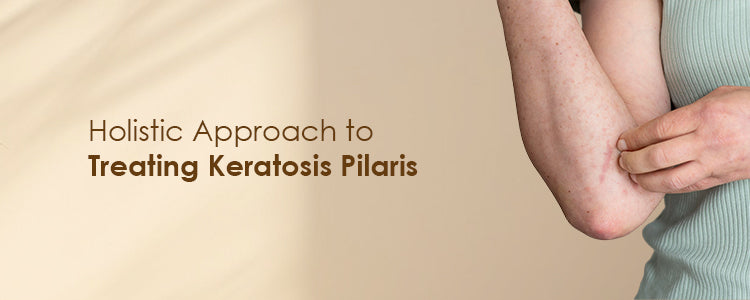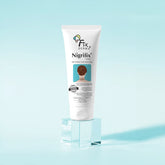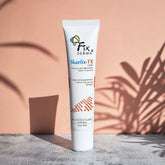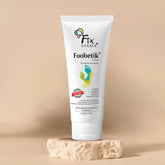Holistic Approach to Treating Keratosis Pilaris

Have you ever noticed tiny, rough bumps on your skin that resemble goosebumps or small pimples? This could be a common skin condition known as Keratosis Pilaris (KP). KP manifests as small, painless bumps caused by the buildup of keratin, a protein that protects the skin. While these bumps are harmless, they can be frustrating and affect your skin's appearance and texture.
Keratosis Pilaris is quite common and can affect people of all ages. The condition can often worsen during the colder months when our skin is drier. Although KP usually doesn’t cause discomfort, it can be bothersome and sometimes lead to self-consciousness among individuals, especially when it appears in visible areas of the body. Let us understand this skin condition better and learn how to treat it.
What is Keratosis Pilaris?
Keratosis Pilaris, also known as "chicken skin," is a common skin condition causing small, rough bumps on the skin's surface. These bumps, usually white or red, can feel dry or like sandpaper. KP is a benign condition and doesn't cause serious medical problems. It is most common in children and adolescents, with symptoms appearing in childhood and continuing into adulthood. Both males and females can get KP, but it becomes more noticeable during teenage years due to hormonal changes. People with dry skin or a history of eczema are more likely to experience Keratosis Pilaris. It commonly appears on the upper arms, thighs, and buttocks, but can also occur in other parts of your body. The bumps are usually painless but can cause mild itching or irritation. KP is primarily caused by genetic factors and the condition worsens during winter months when the air is dry and cold.
Best Way Out - Turn to a Holistic Approach
Holistic treatment is an approach to health and wellness that considers the whole person - body, mind, and spirit, rather than focusing solely on specific symptoms or ailments. In skincare and treating conditions like Keratosis Pilaris, holistic treatment involves lifestyle changes, and dietary adjustments to support overall skin health. Treating Keratosis Pilaris holistically is important because it addresses the root causes of the condition, recognising factors such as diet, stress, and environmental influencers. Holistic treatments for Keratosis Pilaris offer long-term benefits, as gradual and consistent lifestyle changes lead to lasting improvements in your skin texture and appearance.
Dietary Changes for KP
The dietary impact on skin health is significant, especially for those with Keratosis Pilaris (KP). Certain vital nutrients from food are important for skin repair, hydration, and overall skin health. Improve your skin health and manage KP effectively by including nutrient-rich foods like leafy greens, fish, nuts and seeds, fruits, and avocados. These foods provide vitamins A, C, and E, which help in skin repair and protect your skin against free radicals.
Avoid processed foods, sugary snacks and beverages, dairy products, and fried foods high in unhealthy fats. All these can exacerbate Keratosis Pilaris's condition, as they are high in unhealthy fats and can clog your skin pores.
Skincare Routine Adjustments
Gentle Cleansing
If you have Keratosis Pilaris, choose the right kind of cleanser. Go for gentle, non-irritating cleansers that clean your skin without stripping away its natural oils. A gentle cleanser helps maintain your skin’s moisture balance, reducing irritation and the likelihood of keratin buildup. Look for products labelled as hypoallergenic or designed for sensitive skin. Avoid harsh soaps that contain sulfates or strong fragrances, as they can dry out your skin and worsen KP symptoms.
Exfoliation
Regular exfoliation is key to managing Keratosis Pilaris, as it helps remove the buildup of dead skin cells clogging hair follicles. Exfoliating can smooth out the rough texture and improve the appearance of your skin. Alpha-hydroxy acids (AHAs), such as glycolic acid and lactic acid, are also effective. These acids help dissolve the bonds between dead skin cells, making it easier to remove them and reveal smoother skin underneath. Incorporate exfoliation into your routine two to three times a week, but be careful not to over-exfoliate, as this can irritate your skin further.
Moisturization
Moisturization is essential in a skincare routine for Keratosis Pilaris. Keeping your skin well-hydrated helps reduce dryness and can improve the overall texture of your skin. Natural moisturisers such as coconut oil and shea butter are excellent options; they provide deep hydration without irritating your skin. Also, look for products containing urea or lactic acid, as these ingredients help to soften and smooth the skin by gently exfoliating and increasing moisture retention. Additionally, apply moisturiser immediately after bathing while your skin is damp to lock in moisture.
Fixderma’s Moisturizing Cream is a lightweight, non-greasy formula that hydrates and protects dry skin. Suitable for all skin types, it offers long-lasting moisture and combats dullness. Enriched with Vitamin E for sun protection, Allantoin for pH balance and breakout reduction, and Aloe Vera for healing, it keeps skin soft and supple all day.
Lifestyle and Environmental Factors
Hydration
Staying hydrated is one of the simplest yet most effective ways to maintain healthy skin. Drinking enough water ensures that your skin cells are well-hydrated; this helps to maintain skin elasticity and smoothness. Adequate hydration helps your skin repair itself more efficiently, reduces dryness, and prevents Keratosis Pilaris. Drink at least eight glasses of water a day and remember that your hydration needs can increase in hot weather or during physical activity.
Humidifiers
Using a humidifier can significantly benefit your skin, especially in dry climates or during the winter, when indoor heating can strip moisture from the air. A humidifier adds moisture to the environment, helping to keep your skin hydrated. This can prevent the dryness and irritation that often worsen KP symptoms. Place a humidifier in your bedroom to maintain a consistent level of humidity while you sleep, promoting healthier skin overnight.
Clothing Choices
The kind of apparel you wear can impact the condition of your skin, particularly if you have Keratosis Pilaris. Choose breathable, non-irritating fabrics like cotton or linen, which allow your skin to breathe and reduce the risk of irritation. Avoid wearing tight clothing that can rub against your skin, as friction can aggravate KP and lead to increased redness and bumps. So, opt for loose-fitting garments that provide comfort and minimise skin irritation.
Stress Reduction
Stress reduction techniques are important for maintaining healthy skin and managing conditions like Keratosis Pilaris. Yoga, meditation, and regular exercise can help you reduce stress levels, improve flexibility, and enhance mindfulness. Yoga promotes relaxation, flexibility, and mindfulness, which benefits your skin and overall health. Meditation involves focusing on breath and awareness, regulating cortisol levels, promoting better sleep, and improving skin appearance. Regular physical activity releases endorphins, which are natural stress relievers and mood boosters. In addition, activities like walking, gym workouts, or dancing can also help manage stress and improve your skin's vitality.
If you’re struggling with Keratosis Pilaris, know that you’re not alone. Many people deal with this common skin condition, and there are effective ways to manage it naturally. By incorporating gentle dietary changes, adjusting your skincare routine, and adopting stress reduction techniques, you can move toward improving your skin’s texture and appearance. Ensure that you are patient and consistent in your efforts, and don’t be discouraged if you don’t see immediate results. With time and dedication, you may start to notice improvements in your skin’s health and feel more confident in your skin.
We’d love to hear about your experiences managing Keratosis Pilaris or any questions you may have. Feel free to share your thoughts and insights in the comments section below. Together, let’s support each other on the journey to healthier, happier skin.








